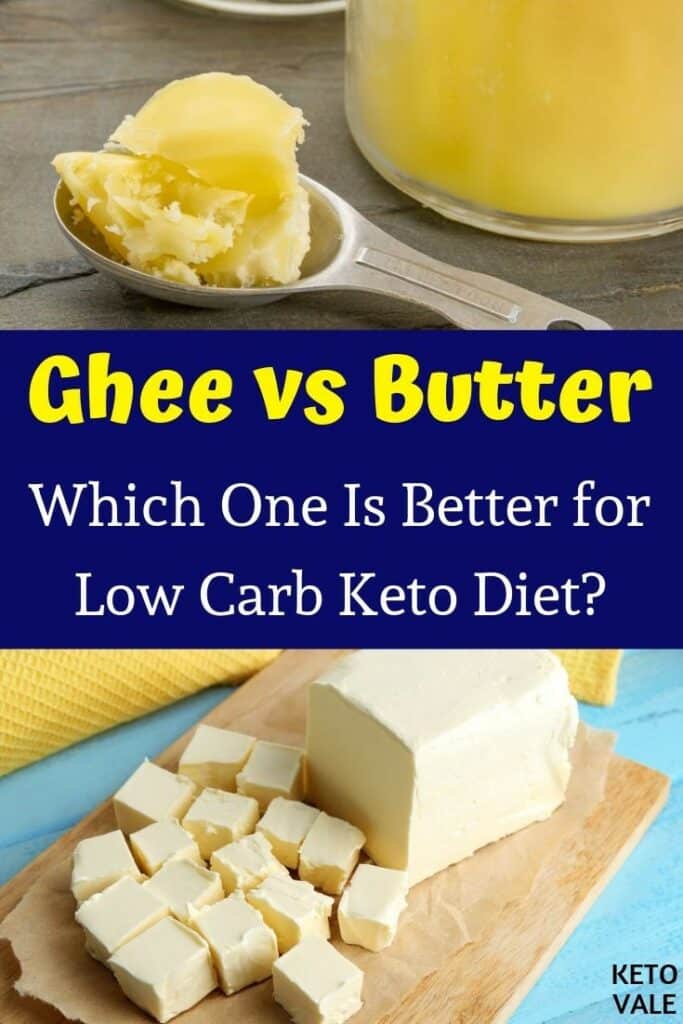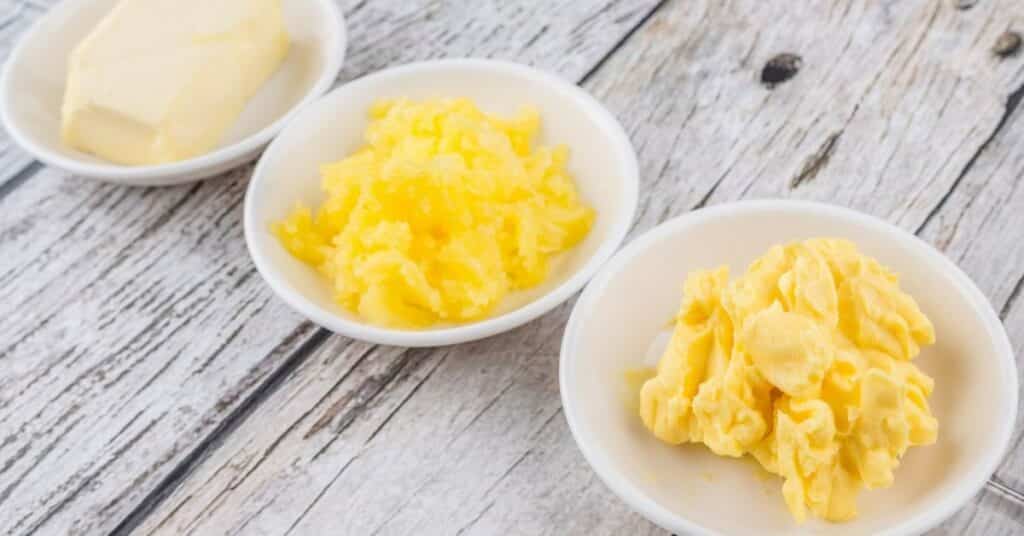Fats are an important part of the ketogenic diet, and some fats are potentially better than others.
Animal fats, which were believed to be harmful because of their high content of saturated fats. However, nowadays researchers understand their role and benefits better, and the consensus is that they do have their place in a healthy diet.
Dairy fats and butter, in particular, has been a subject of a heated debate over the past decades.
Recent research has demonstrated that consuming high-fat dairy (such as butter, ghee, cream, cheese) actually lowers the risk of obesity (1).
In this article, we’ll be looking at two different dairy-based fats that you could use on а keto diet, and namely, butter and ghee.
Butter and ghee are similar products and are often used interchangeably, so we’ll also compare them and see when it’s better to use one over the other.
Butter
There are many different kinds of butter out there. Most commonly butter is made of cow’s milk, but goat or sheep butter also exists.
Salted butter is also commonly available in many supermarkets, and in the context of a ketogenic diet (where you need to supplement with sodium in order to meet your electrolyte needs), it could be a good alternative to butter without added salt.
The debate around butter and its nutritional value has been going on for many years, especially due to its high content of saturated fat – 51% of the fat in butter is saturated (2).
However, saturated fat actually can have its place in a balanced diet, and is current data doesn’t support the idea that it has a negative impact on cardiovascular health and that it increases the risk of heart disease (3).
On the other hand, man-made trans fats contained in many processed foods do have such an impact (4).
There’s nothing inherently unhealthy about butter if you consume it as a part of a healthy diet.
Butter is fat, and therefore it’s very high in calories, so if your goal is weight loss, you should be mindful of the calories you’re getting from it. Always weigh butter (and other fats) with a scale and log them correctly in your food tracking app.
Butter does contain some micronutrients that are important for overall health, such as vitamin A and E. The amounts aren’t sufficiently high for it to make a dramatic difference in the micronutrients you’re getting, but it does contribute to having an overall balanced diet.
It also contains conjugated linoleic acid (CLA), a type of fat that has been shown to be hugely beneficial for improving body composition, and might even have cancer-protective properties (6, 7).
Although the quantities of CLA contained in butter aren’t significant enough to replicate in real life the results of the studies, it’s still considered to be a very beneficial compound, and butter is one of the good dietary sources of it.
Butter also contains butyrate, another fatty acid that has a number of potential benefits. Research has demonstrated that it improves gut health and lowers inflammation levels, and could even be beneficial for people suffering from irritable bowel syndrome (IBS) (8, 9).
Is Butter Necessary For Keto?
Although for many people butter is an important part of a ketogenic diet, it’s not necessarily the case for everyone, and it’s not a must to have food.
It’s a common misconception that the keto diet consists of eating huge amounts of butter and bacon daily. You might prefer to use other fats, and there’s nothing wrong with that.
Good fats for keto are avocado oil, extra virgin olive oil, coconut oil, and different animal fats, such as tallow or lard. Butter is an excellent choice, but if you’re sensitive to it (for example if you’re particularly sensitive to dairy) or if you don’t like its taste, you don’t need it for keto.
Do You Need To Put Butter In Your Coffee?
Bulletproof coffee, or coffee with butter and MCT oil, is popular amongst keto dieters. Some only use butter. Is it necessary to drink your coffee with butter, though?
In short, no, you don’t need to have bulletproof coffee for keto – that’s entirely up to you and depends on your goals and nutritional needs.
Butter in your coffee will add lots of calories without the nutritional value that other foods could provide you with (i.e. without most of the micronutrients that you would be getting from, for example, vegetables), and if your goal is to lose weight, then this is unnecessary and likely not beneficial.
That being said, if you genuinely enjoy coffee with butter and it helps you to control your appetite and stick to your macros consistently, then you can have it.
If you do, make sure that you weigh your butter and track it correctly, as it is very calorically dense and any mistakes will slow down your progress.
Is Grass-fed Butter Even Better?
Grass-fed butter is made from the milk of cows that were fed mostly grass (as opposed to grain) and is thought to be healthier. It also has a more pronounced buttery taste.
Grass-fed butter has a much higher CLA content (about 5 times higher than grain-fed); if you’re looking to increase your CLA consumption, grass-fed butter and meat would be the way to go (10).
The milk of grass-fed cows (from which butter is made) also has a better Omega-3 to Omega-6 ratio (11).
Grass-fed butter tends to have a richer taste than conventional butter, and many people prefer it for that reason.
The French and Irish have a long tradition of making butter, so if you have access to good French or Irish butter, it’s likely going to be of very good quality. Kerrygold is a popular brand of Irish butter that you could easily find in supermarkets.
What Are Butter’s Macros?
Per 100 g: 717 calories, 81 g fat, 0.9 g protein, 0.1 g net carbs.
For a serving of 1 tbsp (14 g): 102 calories, 12 g fat, 0.1 g protein, 0 g net carbs.
Ghee
Ghee is actually a type of butter, it is clarified butter from which milk solids have been removed.
To obtain ghee, butter is heated, which makes milk solids and liquid separate from the fat. Those are then removed and the remaining fat – ghee – is cooled down again. In fact, you could replicate the process at home to make your own clarified butter.
Ghee is traditionally used in India, Pakistan, and Bangladesh, and is now getting more and more popular in Europe and North America. You could buy ghee either from health food stores or from Indian supermarkets (where it would be potentially cheaper).
What Are Ghee’s Macros?
Per 100 grams: 850 to 900 calories, depending on how much of the liquids and solids of butter have been removed; 91 to 100 g fat, 0 g protein, and 0 g net carbs.
For a serving of 1 tbsp (14 grams): around 120 calories, 14 g fat, 0 g protein, and 0 g net carbs.
Ghee vs. Butter: Which One Is Better?
Is Ghee Healthier For You Than Butter?
Nutritionally, ghee and butter are very similar – in fact, ghee is a type of butter. Therefore, as far as the health benefits of both are concerned, they will be nearly identical.
Both butter and ghee contain CLA and butyrate, and both will have a better overall nutritional profile if you choose a grass-fed version over a conventional, grain-fed one.
If you have a strong dairy sensitivity or intolerance, butter might not be optimal for you – in that case, ghee is a better choice, since the milk solids have been removed from it, leaving only the fat.
Butter is slightly less caloric than ghee, as it contains both fats and liquid, while ghee is nearly 100% fat. A hundred grams of butter contain 717 calories, while the same amount of ghee comes at around 850-900 calories.
The difference is not dramatic, but it’s important to properly measure and track both ghee and butter, and especially if your goal is weight loss.
How Do Butter And Ghee Compare For Cooking?
If you’re going to be using fat for frying, ghee is a better choice. Butter is more suitable for sautéing vegetables or baking desserts (yes, you could actually make baked desserts on keto – for ideas, check out our recipes section).
Ghee has a higher smoke point than butter, which is between 400 degrees F to 500 degrees F (204 to 260 degrees C) for ghee versus 325 degrees F to 375 degrees F (163 to 191 degrees C) for butter. For that reason, it’s more suitable for high-temperature cooking, such as frying.
It has a different taste than butter, too, which should be considered when it’s used for cooking – it’s essentially less buttery, due to the additional processing (clarifying), but also nuttier. Ghee has a distinct flavour on its own, and it’s best to try it out to see if you like it.
If you’d like to have a rich buttery taste in the dish you are cooking, then butter would be the better choice, and especially grass-fed butter, which is more flavourful than traditional butter.
The Takeaway
Butter and ghee are quite similar in terms of nutritional value, ghee being slightly more caloric (due to its higher fat content). For people who are particularly sensitive to dairy, they might tolerate ghee much better; if you don’t have a dairy sensitivity, both options are good to add on a low-carb plan.
If you’re concerned with flavour, CLA content and Omega-3 to Omega-6 ratios, grass-fed butter or ghee would be a better option for you. Ghee has a nuttier flavour than butter, and also a much higher smoking point, both of those are important factors to consider when cooking. Apart from that, both can have a place in a healthy diet and choosing one or the other (or both) would be a matter of personal preference.
Enjoy this post? Share to save for later!

Photo credit: akulamatiau/ depositphotos.com







